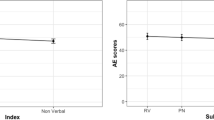Summary
Adaptive behaviour was assessed in a total of 119 mentally retarded adults by means of the Disability Assessment Schedule (DAS). According to a newly developed classification scheme, the level of handicap was graded on a four-step scale according to the subject's score in adaptive behaviour on the DAS; this was highly correlated both to the Coloured Progressive Matrices (CPM)-IQ (r=0.75) and the Columbia Mental Maturity (CMM) Scale (r=0.77). The DAS classification was associated with relevant neuropsychiatric variables. The findings indicate that the DAS classification represents a practicable way for assessing the degree of handicap in mentally retarded adults and could be especially valuable in cases where intelligence testing proves impossible, as was the case for 45% (CPM) and 39% (CMM) of the present sample.
Similar content being viewed by others
References
Aman MG, Singh NN (1988) Patterns of drug use: methodological considerations, measurement techniques and future trends. In: Aman MG, Singh NN (eds) Psychopharmacology of the developmental disabilities. Springer, New York, pp 1–28
American Psychiatric Association (APA) (1987) Diagnostic and statistical manual of mental disorders, 3rd edn, revised. American Psychiatric Association, Washington, DC
Berger M, Yule W (1985) IQ tests and assessment. In: Clarke AM, Clarke ADB, Berg JM (eds) Mental deficiency: the changing outlook. Methuen, London, pp 53–96
Bondy C, Cohen R, Eggert D, Lüer G (1969) Testbatterie tur geistig behinderte Kinder. Beltz, Weinheim
Bruininks RH, Thurlow M, Gilman CJ (1987) Adaptive behavior and mental retardation. J Spec Educ 21: 69–88
Clarke AM, Clarke ADB (1985) Criteria and classification. In: Clarke AM, Clarke ADB, Berg JM (eds) Mental deficiency: the changing outlook. Methuen, London, pp 27–52
Cooper B, Liepmann MC, Marker KR, Schieber PM (1979) Definition of severe mental retardation in school-age children: findings of an epidemiological study. Soc Psychiatry 14: 197–205
Cooper B, Jennen-Steinmetz C, Lackus B, Ort M (1987) Patterns of impairment and disability in mentally retarded children: a study in Mannheim. In: Cooper B (ed) Psychiatric epidemiology: progress and prospect. Croom Helm, London, pp 267–284
Eyman RK, Call T (1977) Maladaptive behavior and community placement of mentally retarded persons. Am J Ment Defic 82: 137–144
Grossman HJ (1983) Classification in mental retardation. American Association on Mental Deficiency, Washington, DC
Heber R (1961) A manual on terminology and classification in mental retardation. Am J Ment Defic [Monogr Suppl]
Holmes N, Shah A, Wing L (1982) The Disability Assessment Schedule: a brief screening device for use with the mentally retarded. Psychol Med 12: 879–890
Kamphaus RW (1987) Conceptual and psychometric issues in the assessment of adaptive behavior. J Spec Educ 21: 27–35
Kiely M (1987) The prevalence of mental retardation. Epidemiol Rev 9: 194–218
Luckasson R (1992) International implications of the proposed 1992 AAMR definition of mental retardation. Paper presented at the 9th World Congress of IASSMD, Gold Coast, Australia
Meins W (1989) Behandlung mit Antiepileptika-eine Erhebung bei geistig behinderten Erwachsenen. Rehabilitation 28: 10–14
Menolascino FJ (1990) The nature and types of mental illness in the mentally retarded. In: Lewis M, Miller SM (eds) Handbook of developmental psychopathology. Plenum Press, New York, pp 397–408
Orme JE (1966) Hypothetically true norms for the Progressive Matrices Tests. Hum Dev 9: 222–230
Ort M (1981) Patterns of impairment in relation to psychometric test results. In: Cooper B (ed) Assessing the handicaps and needs of mentally retarded children. Academic Press, New York, pp 155–167
Raynes NV (1988) Adaptive behaviour scales. In: Hoog J, Raynes NV (eds) Assessment in mental handicap. Croom Helm, London, pp 81–106
Ross RT (1972) Behavioral correlates of levels of intelligence. Am J Ment Defic 76: 545–549
Schmidtke A, Schaller S, Becker P (1978) RAVEN-Matrizen-Test (CPM) Beltz, Weinheim
Schroeder SR (1991) Self-injury and stereotypy. In: Matson JL, Mulick JA (eds) Handbook of mental retardation. Pergamon Press, New York, pp 382–396
Smith B, Phillips CJ (1992) Attainments of severely mentally retarded adolescents by aetiology. J Child Psychol Psychiatry 33: 1039–1058
Zigler E, Balla D, Hodapp R (1984) On the definition and classification of mental retardation. Am J Ment Defic 89: 215–23
Author information
Authors and Affiliations
Rights and permissions
About this article
Cite this article
Meins, W., Süßmann, D. Evaluation of an adaptive behaviour classification for mentally retarded adults. Soc Psychiatry Psychiatr Epidemiol 28, 201–205 (1993). https://doi.org/10.1007/BF00797324
Accepted:
Issue Date:
DOI: https://doi.org/10.1007/BF00797324




